Break out your bundt pan for this Kentucky Butter Cake. The sweet, moist crumb of the cake is complimented by the crunchy sugar exterior formed by drenching the cake in a homemade butter glaze.
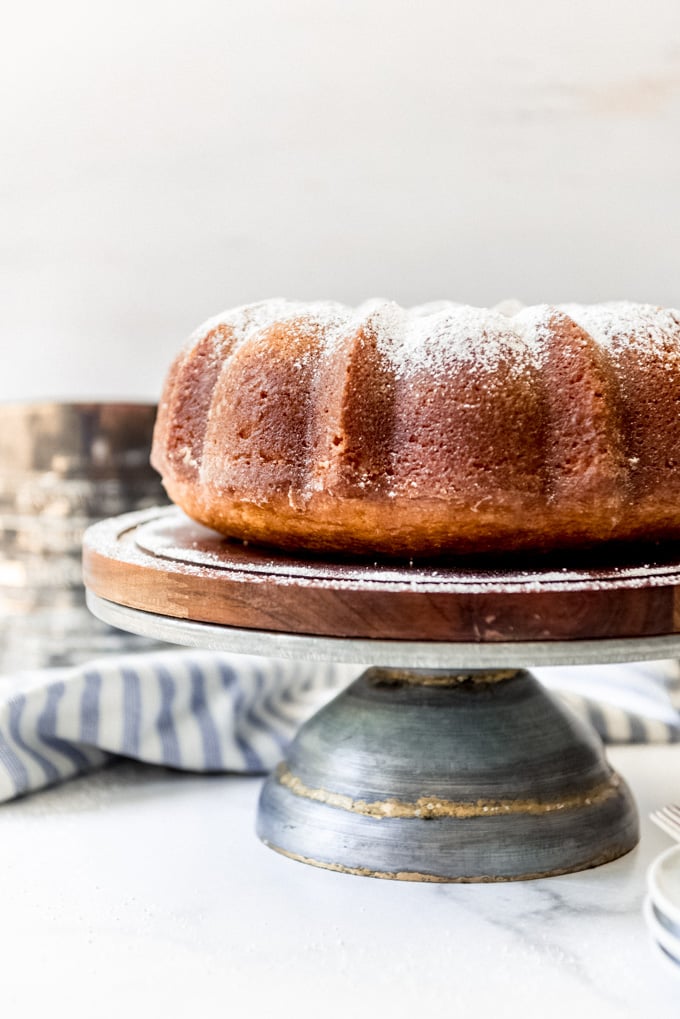
If you are interested in making a full Kentucky meal, be sure to also check out our Hot Brown Sandwiches, Southern Fried Chicken, Virgin Mint Juleps, and Kentucky Chocolate Chip Walnut Pie!
What is Kentucky butter cake?
Kentucky butter cake is a classic Southern pound cake with a moist, tender crumb and sweet butter glaze that makes it taste almost like a cake version of an old-fashioned doughnut. After the bundt cake is baked, it’s poked with holes while still in the pan. Then a sweet, warm butter sauce is poured over the bottom that soaks into the cake and sets up to form a cake like no other with a delicious crunchy sugar crust.
The butter sauce is simple with just four ingredients – butter, sugar, water, and vanilla. The first three are combined in a small saucepan and heated to just a simmer for 5 minutes until slightly thickened and syrupy. Then the vanilla is stirred in before it is poured directly onto the warm cake.

Thanks to that butter glaze, the cake stays fresh and flavorful for days so it’s perfect for making ahead. I love when a dessert is just as wonderful (some say better!) the next day as when it was made.
I wanted to share this Kentucky butter cake recipe as part of Kentucky Week for my American Eats series where I’m making some of the namesake and most-popular recipes of each state in the U.S., one state at a time.

I’m always looking for new bundt cake recipes since I love how they look and present. Some other cakes I have shared using my classic bundt pan are pear ginger bundt cake and sour cream pound cake.
How to make Kentucky butter cake
- Prep a 12-cup bundt pan & preheat the oven. I like to use Baker’s Joy (affiliate link) which is a baking spray with flour in it. If that isn’t available, use softened butter and a pastry brush to generously coat every crevice of your bundt pan. Add 2 tablespoons of flour and shake the pan to coat every surface before knocking out any excess flour. Preheat the oven to 350°F.
- Cream the butter and sugar. This is such an important step in baking as it makes for a light and fluffy cake. The butter and sugar might look mixed after just 30 seconds, but let the mixer keep running on medium high for about 3 minutes until they are light and fluffy. As the butter and sugar are mixed together, air is added to the batter. This helps give the cake it’s fine crumb and wonderful texture.
- Add the vanilla and eggs. Beating in room temperature eggs one at a time also helps contribute to even ingredient distribution throughout the batter as well as a light, tender crumb. Stop and scrape down the sides of the bowl at least once or twice during this process.
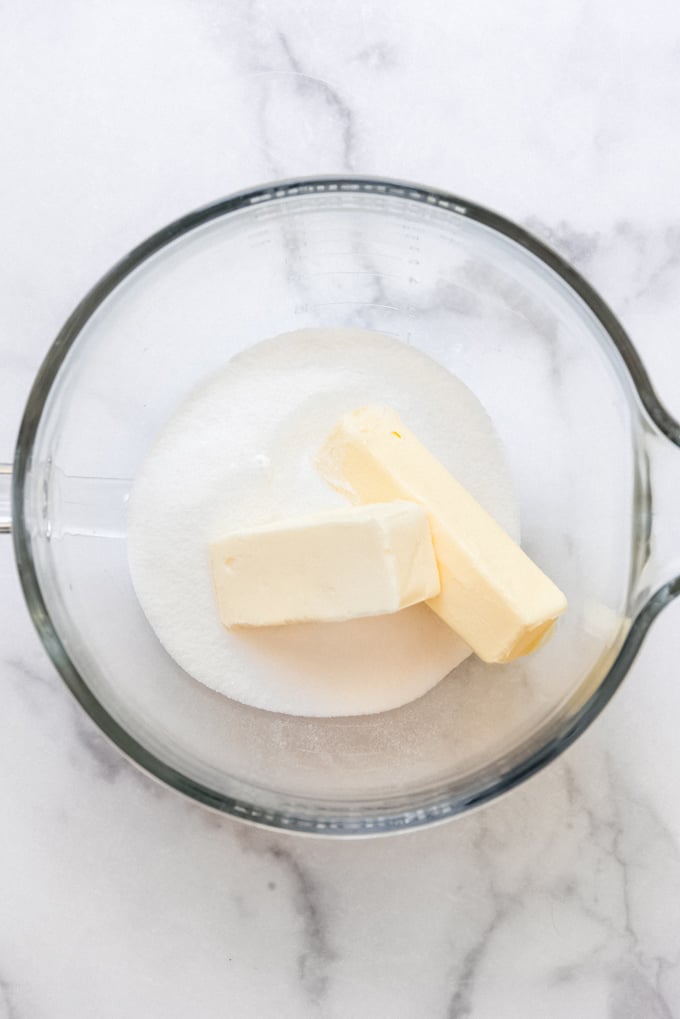
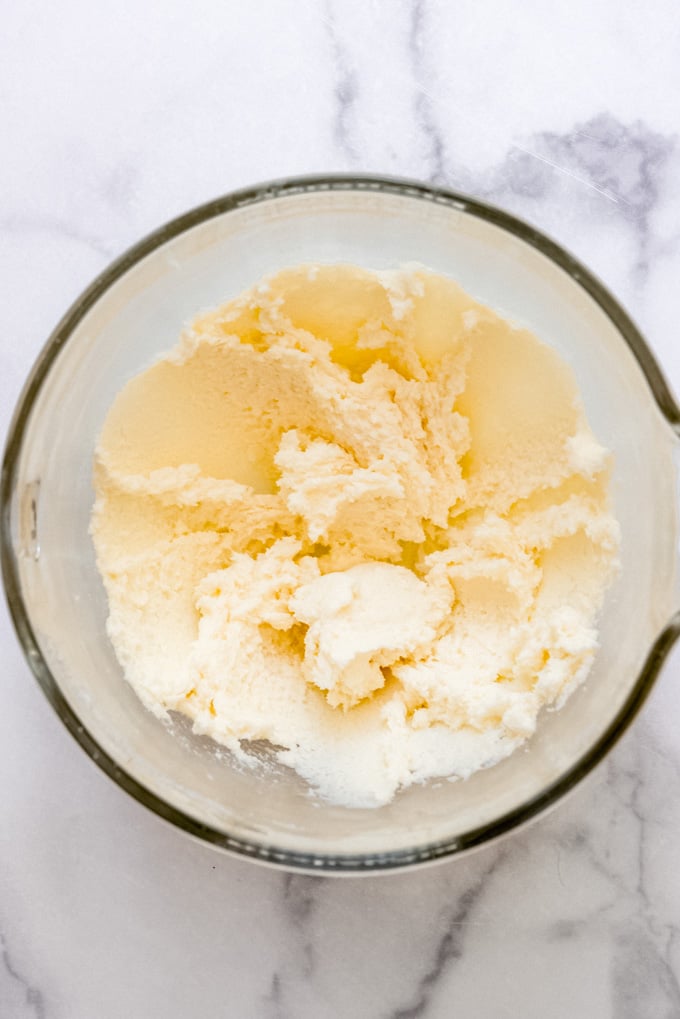
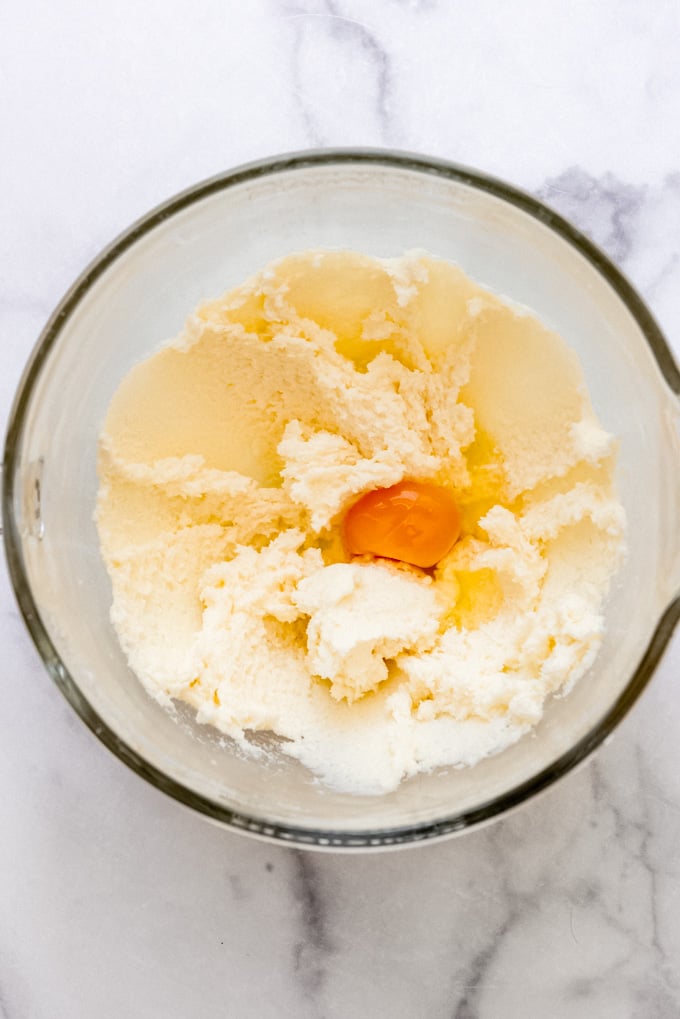
- Alternate adding dry ingredients and buttermilk. With the mixer on low speed, add ⅓ of the flour with the baking powder, and salt. Mix just until combined. Then add ½ of the buttermilk, continuing to alternate with the remaining flour and buttermilk. Mix until combined, then stop and scrape the bowl before giving it one final mix.
- Pour into the prepared pan and bake for 50-60 minutes. You can check to see if the cake is done around the 50 minute mark. Insert a tooth pick or skewer into the thickest center part of the cake to test it. If it comes out wet, let the cake bake for a few minutes longer before checking again. When the tester poked into the center comes out clean with just a few crumbs clinging to it, it’s done.
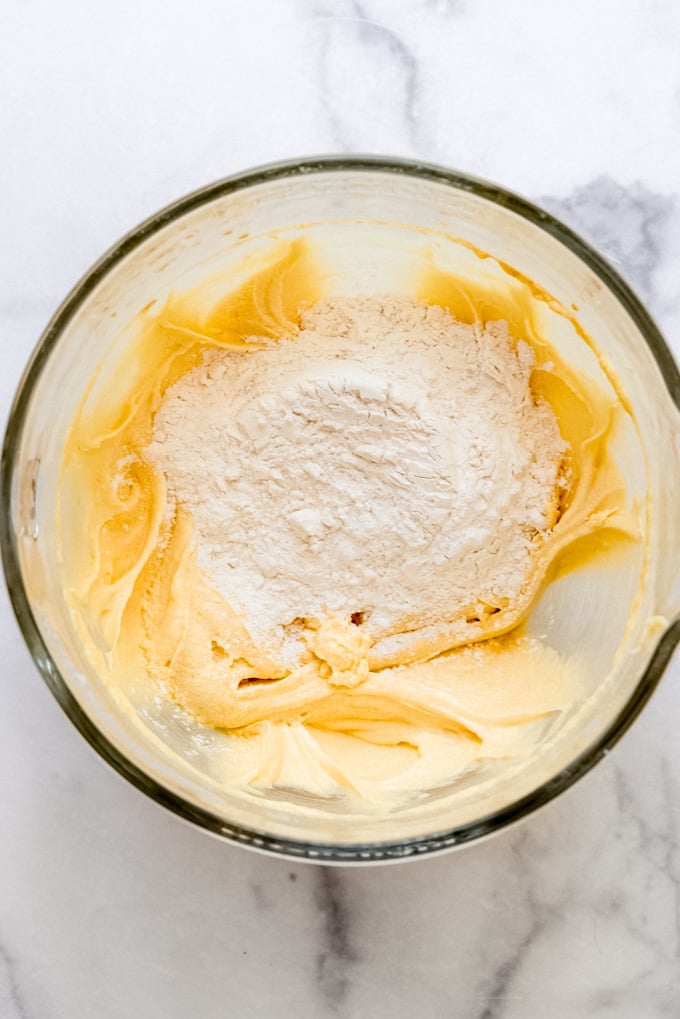
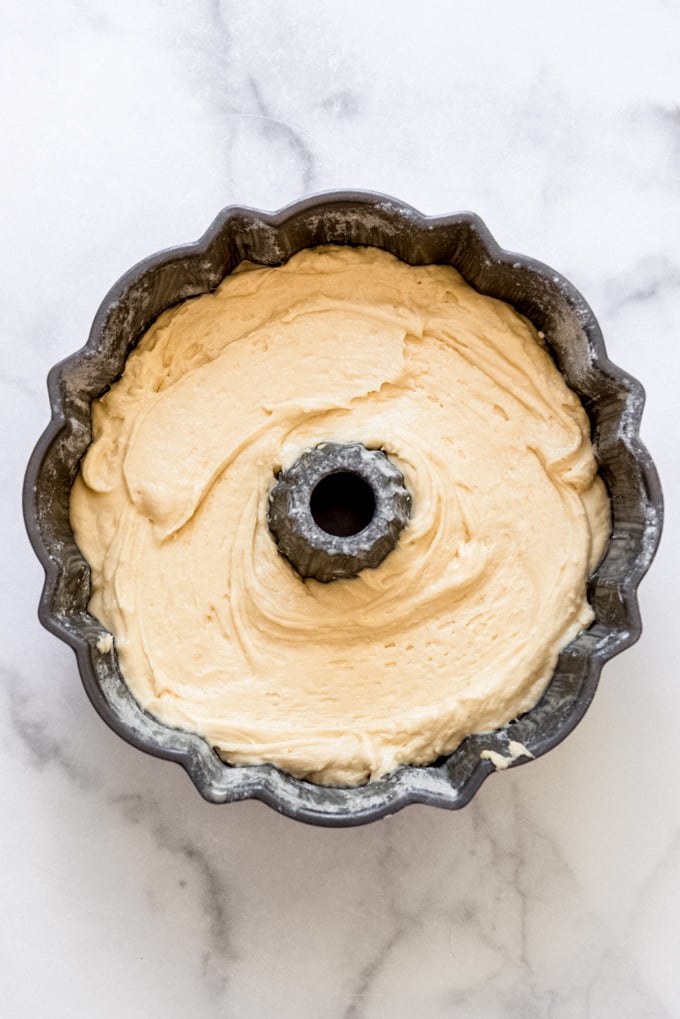
- Make the glaze. This part is super easy. Just combine butter, sugar, water, and salt in a small saucepan set over medium heat. Let it heat to a simmer and cook until the butter melts and the sugar dissolves. After about 5 minutes, remove the slightly thickened butter sauce from the heat.
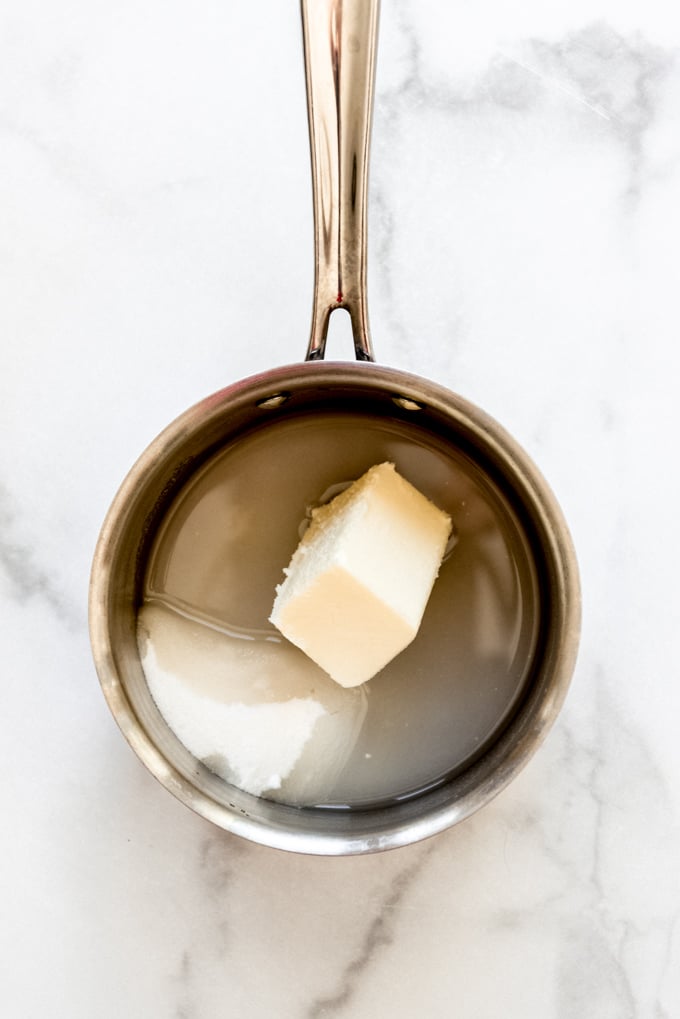
- Add the glaze to the cake. With the warm cake still in the bundt pan, use a skewer to poke holes all over the cake. Slowly pour about 2/3 of the glaze over the top, letting it soak into the holes. It might seem like a lot of liquid, but the cake will soak it all up. Let it soak in for 30 minutes before inverting the pan on to a serving plate or cake stand. Brush the rest of the glaze over the outside of the cake using a pastry brush. Dust the cake with powdered sugar before serving.

You can serve the cake as is, or with some fresh fruit like berries. I also love it with a little fresh lemon curd and whipped cream.
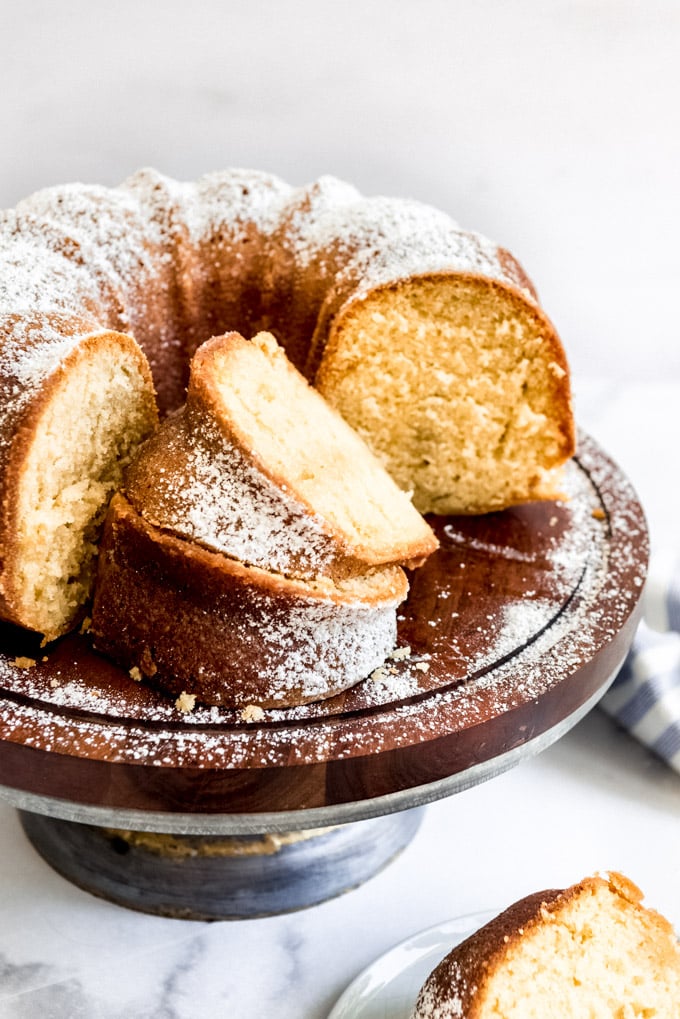
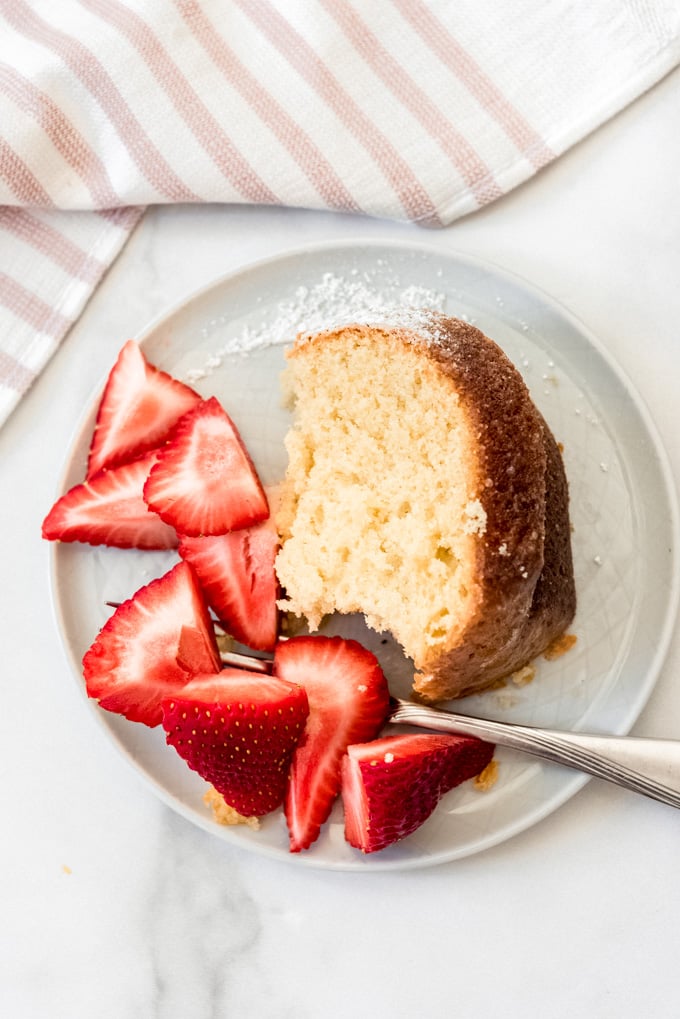
Tips for making bundt cakes
- Always be sure to grease and flour your pan well. Cooking spray doesn’t work great, in my experience. Instead, brush or rub butter or shortening around the inside of the pan. Make sure to hit all the crevices, then add flour and knock it around to coat the pan. A baking spray with flour in it like Baker’s Joy (affiliate link) will also work.
- Adjust your oven racks before preheating the oven. Sometimes I need to move oven racks around a bit to have room for my tall bundt pan to bake in the center of the oven. It’s much easier to do when the oven is still cold.
- Don’t overmix the batter when adding the flour. Beat air into it while creaming the butter and sugar, as well as when mixing in the eggs one at a time. But after that, you are just mixing to combine and alternating ingredients to make sure everything is incorporated well.
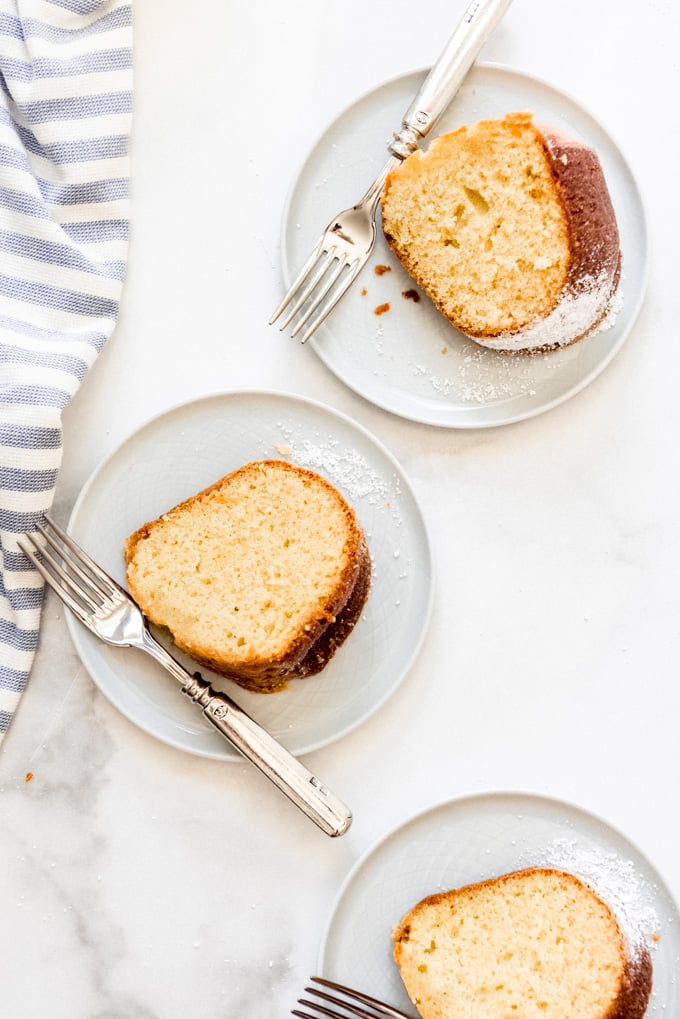
More cake recipes you’ll love
- Sour Cream Pound Cake
- Tres Leches Cake
- Sour Cream Coffee Cake
- Best Carrot Cake Recipe
- German Apple Cake
- Lane Cake
- Sock It To Me Cake
Did you make this recipe?
Let me know what you thought with a comment and rating below. You can also take a picture and tag me on Instagram @houseofnasheats or share it on the Pinterest pin so I can see.
Kentucky Butter Cake
Ingredients
Cake
- 2 cups granulated sugar
- 1 cup salted butter softened
- 4 large eggs room temperature
- 3 teaspoons vanilla extract
- 3 cups all-purpose flour
- 1 teaspoon baking powder
- 1/2 teaspoon baking soda
- 1 teaspoon salt
- 1 cup buttermilk
- Powdered sugar for dusting
Glaze
- 6 Tablespoons salted butter
- 3/4 cup granulated sugar
- 1/4 cup water
- 2 teaspoons vanilla extract
Instructions
- Preheat the oven to 350°F. Spray a bundt pan with Baker's Joy which is a baking spray with flour in it. If that isn't available, use softened butter and a pastry brush to generously coat every crevice of your bundt pan. Add 2 tablespoons of flour and shake the pan to coat every surface before knocking out any excess flour.
- Beat butter and sugar on medium high for about 3 minutes until creamy and light. Add vanilla and eggs, one at a time, mixing well and scraping the bottom and sides of the bowl.2 cups granulated sugar, 1 cup salted butter, 4 large eggs, 3 teaspoons vanilla extract
- With the mixer on low speed, add ⅓ of the flour, baking powder, baking soda, and salt. Mix just until combined. Then add ½ of the buttermilk, mixing again just until combined. Continue alternating adding remaining flour and buttermilk, mixing just until combined. Stop and scrape the bowl as needed.3 cups all-purpose flour, 1 teaspoon baking powder, 1 teaspoon salt, 1 cup buttermilk, ½ teaspoon baking soda
- Pour into the prepared pan and bake for 50-60 minutes. Check to see if the cake is done around the 50 minute mark. Insert a tooth pick or skewer into the thickest center part of the cake to test it. If it comes out wet, let the cake bake for a few minutes longer before checking again. When the tester poked into the center comes out clean with just a few crumbs clinging to it, it's done.
- Combine butter, sugar, and water in a small saucepan set over medium heat to make the glaze. Let it heat to a simmer and cook until the butter melts and the sugar dissolves. After about 5 minutes, remove the slightly thickened butter sauce from the heat and stir in vanilla.6 Tablespoons salted butter, ¾ cup granulated sugar, 2 teaspoons vanilla extract, ¼ cup water
- With the warm cake still in the bundt pan, use a skewer to poke holes all over the cake. Slowly pour about 2/3 of the glaze over the top, letting it soak into the holes. It might seem like a lot of liquid, but the cake will soak it all up. Let it soak in for 30 minutes before inverting the pan on to a serving plate or cake stand. Brush the rest of the glaze over the outside of the cake using a pastry brush. Dust the cake with powdered sugar before serving.Powdered sugar
Nutrition
More States I Have Visited in my American Eats Series
Alabama • Alaska • Arizona • Arkansas • California • Colorado • Connecticut • Delaware • Florida • Georgia • Hawaii • Idaho • Illinois • Indiana • Iowa • Kansas • Kentucky • Louisiana • Maine • Maryland • Massachusetts • Michigan • Minnesota • Mississippi • Missouri • Montana • Nebraska • New Jersey • New York • Oregon • Puerto Rico • South Carolina • South Dakota • Texas • Utah • Wisconsin
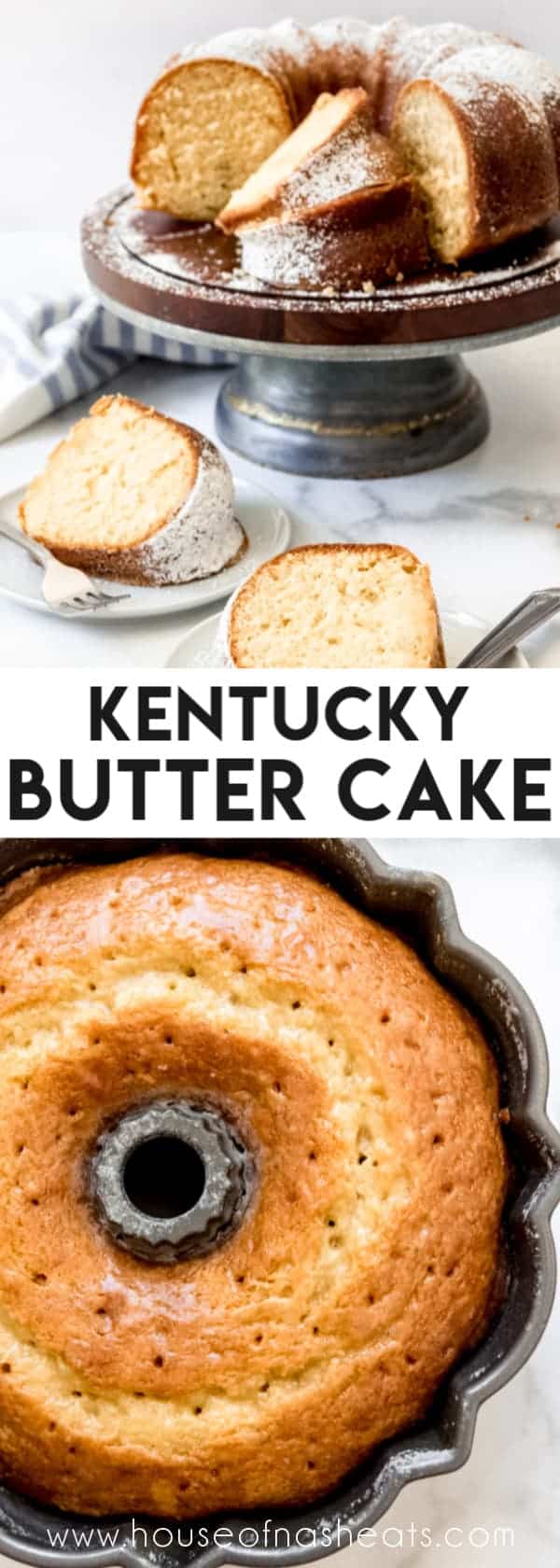
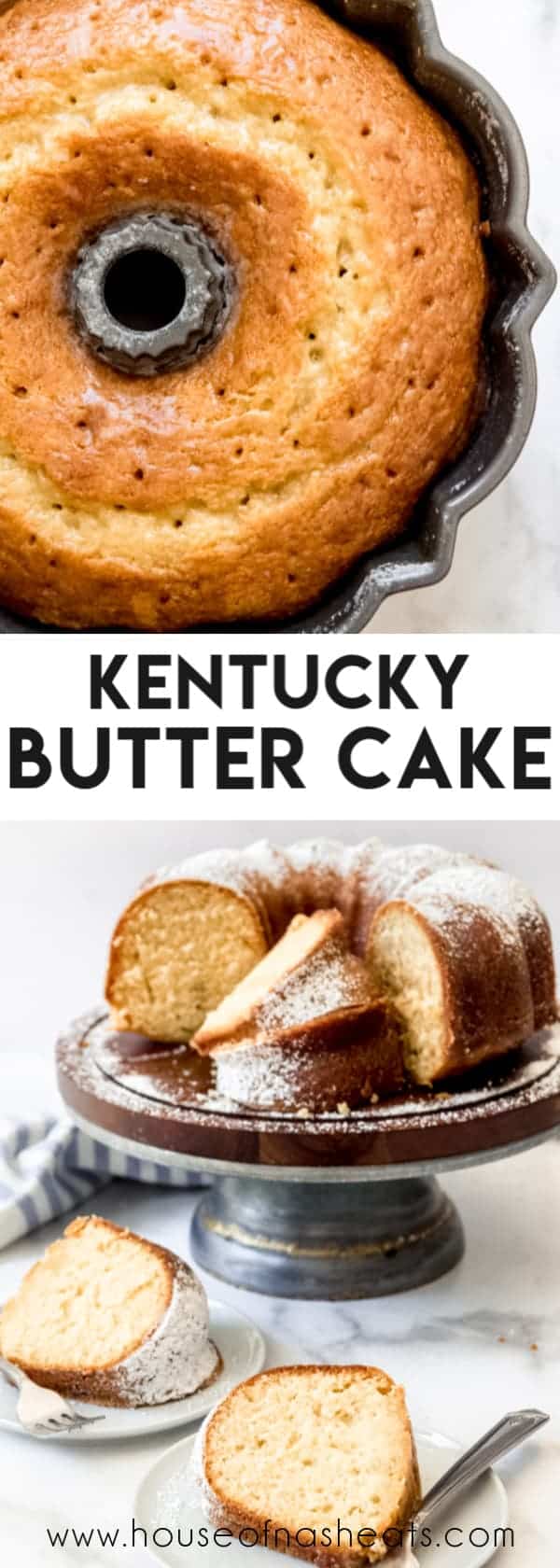
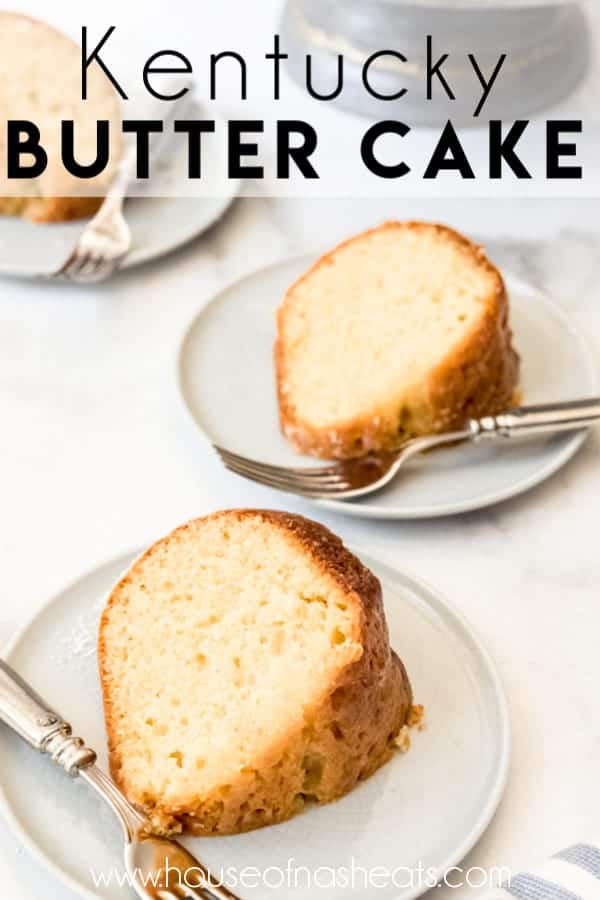
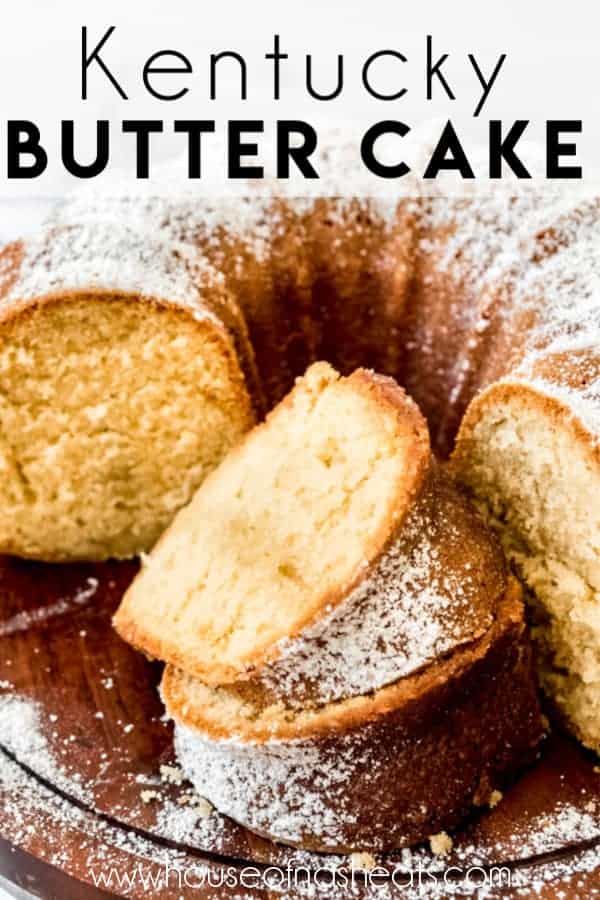
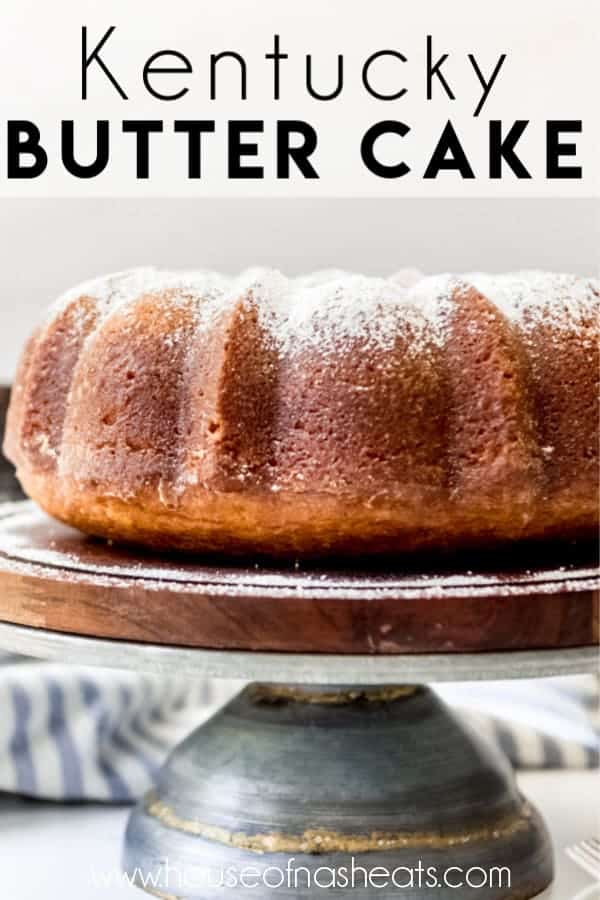
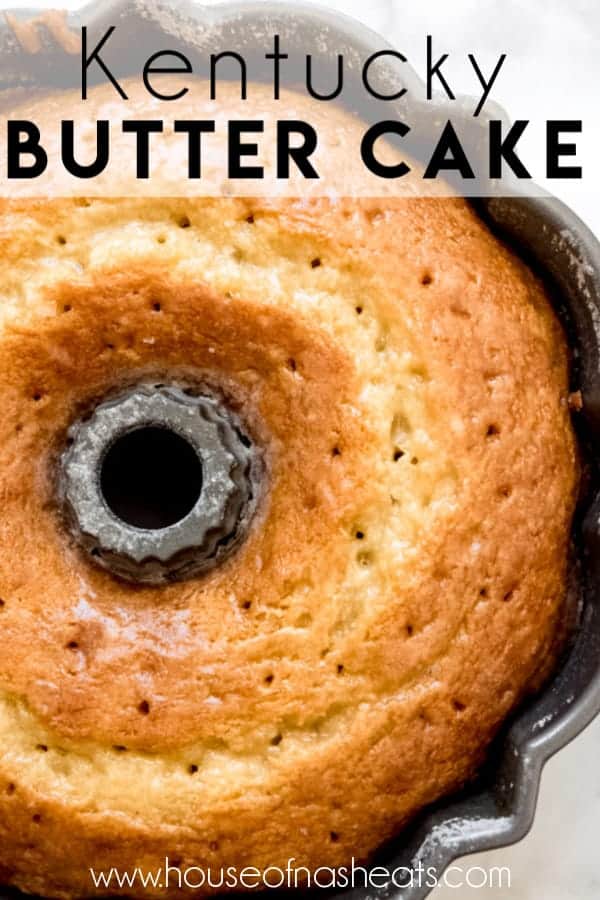
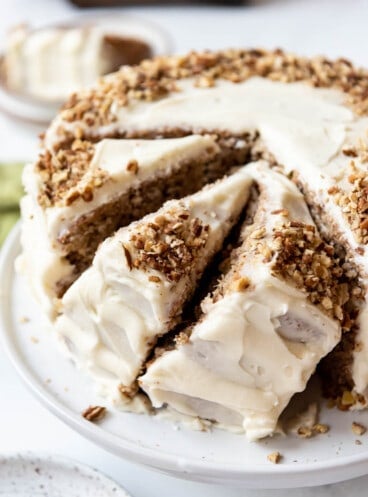

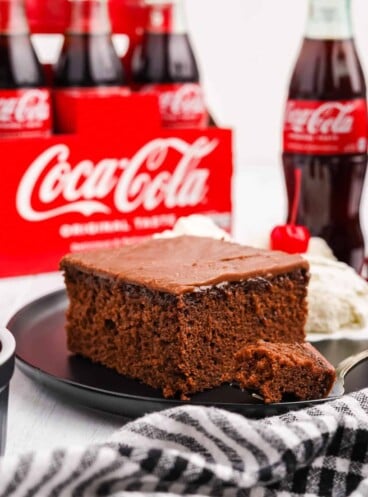
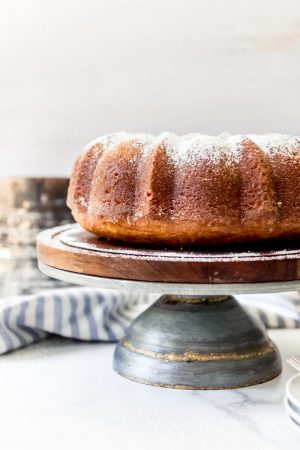
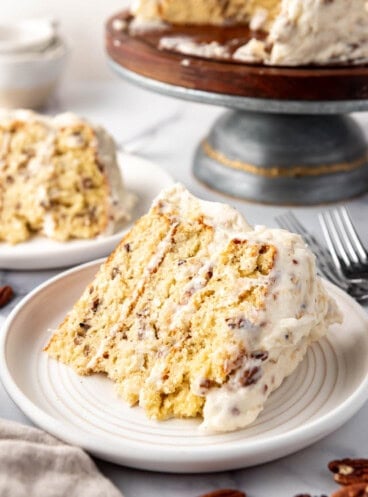
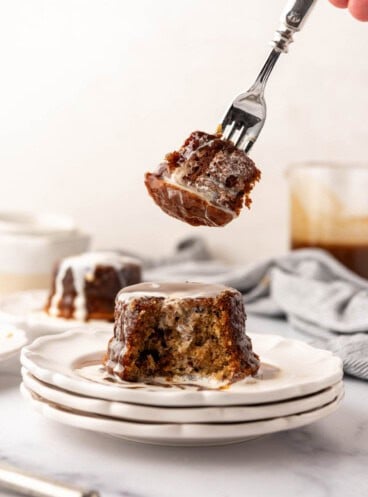
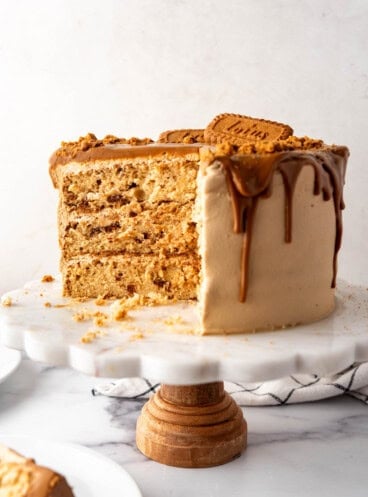
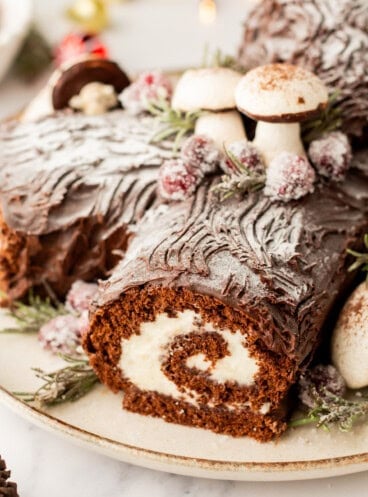

Good morning,
When you were in a Maine & Massachusetts why didn’t you stop in New Hampshire?
The most beautiful New England state!
Hi I have a 6-cup Bundt pan. I’m wondering about halving the entire recipe? Would you cut the baking time in half? Thanks so much!
I think that would be a good starting point. I don’t have a 6-cup Bundt pan yet, though, so if you care to share your experience that would be helpful!